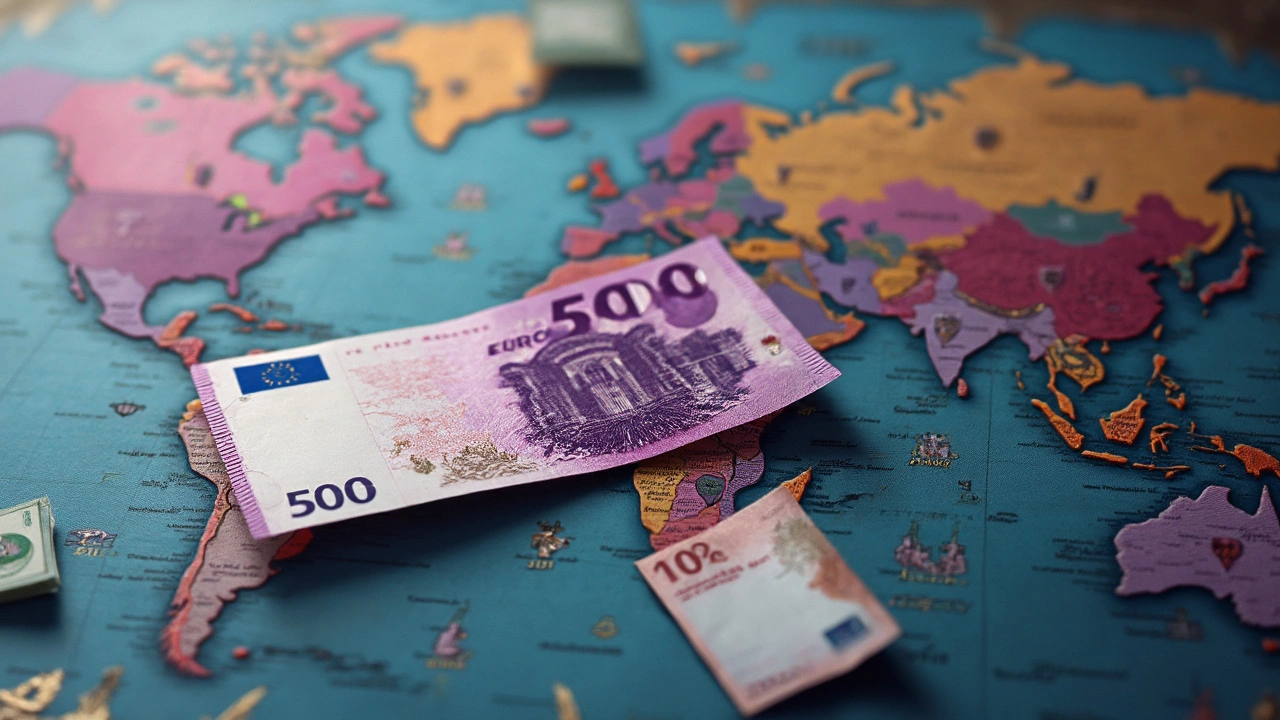
Gone are the days when a crisp 500 euro note could be slipped into your wallet as a show of affluence. Back in 2019, the European Central Bank (ECB) decided to stop producing these eye-catching purple bills, and since then, their rarity has only piqued curiosity. But are they really rare, or just taking an extended holiday?
The ECB's decision wasn't random. Concerns over money laundering and other illegal activities played a huge part. But does that mean it's all doom and gloom for these high-value notes? Not quite. They're not illegal, and you might just spot one lounging in the shadowy corners of some bank vaults or private collections.
If you're lucky (or perhaps unlucky), to have come across one, you might wonder what to do with it. Since banks still accept them, your local branch could be your best bet if you're looking to swap it for smaller notes or deposit it into your account. Collectors also have a soft spot for them, so hang onto it if you're in no rush to cash out.
- The Journey of the 500 Euro Note
- Why Stopped Issuing?
- Current Circulation Status
- Spotting One in the Wild
- Collector's Perspective
- Practical Tips on Handling
The Journey of the 500 Euro Note
Introduced in 2002 alongside its colorful siblings, the 500 euro note quickly became a talking point. Sporting a royal purple hue and an image of modern architecture, it wasn't just the largest euro banknote in size, but in value too. Its release was part of the euro's grand entrance to the world stage, unifying a number of European countries under one currency with a flourish.
Why such a high denomination? The idea was to make cash transactions more convenient, especially for those who dealt across borders. Imagine traveling from Portugal to Germany with a stack of 50 euro notes; quite a hefty wallet workout! However, this convenience came with a downside. The 500 euro note soon earned a reputation among criminal circles, where it became almost a currency in its own right for illegal activities.
Fast forward to 2016, the ECB announced it would halt printing these big bills. They weren't being completely phased out but stopped being issued as of 2019. Remarkably, they still remain legal tender, which means if you happen to have one, it’s not Monopoly money. Banks will accept them for deposit or exchange, so you won’t be left high and dry.
The 500 euro's story is quite a twisted tale of intention versus reality. It was meant as a boon for businessmen and international travelers but turned into a underworld private banker! For collectors today, possessing one has a unique thrill—it’s a relic of a different era, and who knows, might hold more than just face value with time!
Why Stopped Issuing?
Alright, let's get into the nitty-gritty of why they stopped printing the 500 euro note. Long story short, concerns over these bills being used for illegal activities were front and center. Imagine trying to carry a suitcase full of cash — it's much easier to do with fewer, higher value notes, right? That's exactly what money launderers and other criminals thought too.
The European Central Bank (ECB) caught onto this pattern real quick. Despite their legitimate uses, such as for large transactions and among collectors, the 500 euro note was a hot favorite in questionable circles. In May 2016, after much debate and consultation, the ECB decided it was time to call it quits and announced that it would stop issuing these notes by the end of 2018.
Interestingly enough, Germany ranked as one of the top countries where these notes were most common. It wasn't so much about criminal activity there, but more about old-school habits of using cash for big purchases. However, the bigger picture of its misuse on the international stage couldn't be ignored.
Here’s a juicy tidbit: even though they're out of print, the 500 euro notes are still considered legal tender across the eurozone. People and businesses can use them to pay or deposit them into banks. The banks themselves might just send them back to the ECB, but they sure aren't getting new ones in return!
This decision was a big step in the effort to tighten anti-money laundering regulations and improve financial transparency. Oh, and in case you were wondering, no other euro banknote denomination met the same fate — so far, that is!
Current Circulation Status
The 500 euro note may not be rolling off the mint machines anymore, but it's far from extinct. As of 2025, these notes are still in circulation, although significantly reduced. The European Central Bank (ECB) made a clear decision to halt the issuance back in 2019, so whatever's out there, is out there for good.
You might be wondering just how many of these purple giants are floating around. Well, rumors and reports suggest that millions of these notes are still in the hands of the public, squirreled away in safes, stuffed in wallets, or tucked behind picture frames. Banks are still obligated to exchange them, and they remain legal tender across the eurozone.
Where Can You Find Them?
It’s not every day you come across such a hefty bill while buying groceries, but they occasionally surface in high-end markets, especially real estate and luxury goods. Collectors also have a keen eye for them, which can drive demand up, despite the phased-out status.
If you have access to economic circles or are involved in high-cash businesses, there's a slim chance you might encounter them more often. For the average person, though, they might seem more like a myth or a ghost from the past unless you happen to raid grandma’s old savings stash and find a surprise.
The ECB's Role
The ECB has assured the public that despite stopping production, these notes will retain their value indefinitely. The transition has been gradual, with no rush to pull them from circulation. This helps to maintain financial stability without unnecessarily jarring the market.
So, what does this mean for you? If you stumble upon a 500 euro note, you're holding onto a piece of currency history. While it may not be the workhorse it once was, it still packs a punch when it comes to impressing collectors or making a substantial deposit.

Spotting One in the Wild
If you're on the lookout for a 500 euro note, it's like trying to find a unicorn trotting through the financial world. These hefty notes are still legal tender, but catching sight of one is becoming increasingly rare. So, where might you find them resting today?
Your Best Bet: Banks and Large Exchanges
Banks are probably your best hunting ground. They hold onto these notes longer than your regular shops or smaller banks. If you’ve got a personal banker, they might be your inside secret for spotting these elusive high-value bills. Travel centers and large currency exchanges can also be a place to watch out for, especially in global hubs where large transactions are more common.
In the Hands of Collectors and Business Moguls
Some collectors hoard them for their historical and scarcity value. Check collector auctions or coin fairs for a chance to see or even purchase one. Business folks dealing in international trade might still use them, particularly in industries and places where cash is king.
Quick Tip: You won't be able to find these notes in everyday retail settings. Local stores will likely turn you away or ask for change due to its rarity and high value.
Traces in Statistics
Between 2018 and 2023, reports indicated that about 17% of Europeans had seen or held a 500 euro note at some point. However, today that number is dwindling, as some businesses outright refuse to accept them due to change hassles or fear of counterfeit.
Eligibly Exchanging
If you happen to get lucky and find one, remember, you can still exchange or deposit them at banks. Keep your bank updated with recent exchange policies, as rules can change. Hold onto it if you think its scarcity might make it worth more down the road.
So, next time you hear about a 500 euro bill sighting, you’ll know where to look and what to consider. Maybe you'll be that lucky person who spots one in the wild!
Collector's Perspective
It's no surprise that the 500 euro note has garnered attention among collectors. Even though the ECB stopped printing these bills, their charm hasn't faded, making them a prized possession for numismatics worldwide.
What's the Fuss About?
First off, the design of the 500 euro note is part of its allure. Known for its bold purple color and filled with architectural imagery celebrating modernity, this note catches the eye. But aesthetics aside, its increasing scarcity adds to the demand. Few people outside Europe have even laid eyes on one!
Cashing In: Are They Worth More?
Value appreciation is another reason collectors grab these notes. While they're officially worth €500, some enthusiasts are willing to pay a premium, especially for notes in pristine condition. Think of it like having a rare baseball card in mint condition—it's likely to fetch a better price!
| Condition | Potential Value |
|---|---|
| Used | €500-€520 |
| Uncirculated | €550-€600 |
Keeping it Real
If you're considering hanging onto one for your collection, be mindful of counterfeits. It's always wise to have your note authenticated by a reputable dealer. Genuine 500 euro notes have intricate security features like holograms, raised print, and watermarks that are tough to replicate.
So, if you've got one—or a curious streak about rare currency—consider diving into the collector's world. Who knows? That single bill could be the start of a fascinating, potentially lucrative, hobby!
Practical Tips on Handling
So, you have a 500 euro note and you're wondering how best to deal with it in a world where they're becoming as rare as unicorns. Well, fear not, because we've got some tips to make your life easier while handling these high-value bills.
1. Cashing In at Banks
Banks are still your best option if you want to convert your 500 euro note into smaller denominations. Despite the ECB halting its production, the note is still legal tender across the Eurozone. Just stroll into your local bank and they should happily oblige in helping you swap it out. Just remember to bring some ID—it could be part of their policy for high-value exchanges.
2. Using It in Transactions
Planning to use your 500 euro note in stores? Be prepared for some wary looks. While it's still accepted, not all businesses might be willing or able to make a transaction that large due to cash-saving practices. Bigger establishments, maybe like luxury hotels or branded stores, are more likely to accept it, so save it for those occasions.
3. Understanding Collector's Value
If you're not in a hurry, it might be worth your while to hold onto it. Collectors' interest often increases as availability decreases, and it's possible the value could rise above 500 euros in their circles. A seasoned collector once said,
"Money's worth isn't just in its face value but in its story and scarcity,"emphasizing the allure these notes might have in the future.
4. Safety and Storage
Finally, ensure your 500 euro notes are stored safely. Thin plastic sleeves can help keep them in mint condition, especially if you're thinking of banking on its collector's appeal down the line. You don't want them to look like they just survived a washing machine cycle!
Remember, it's all about perception—while they may be dwindling in circulation, they could be holding a secret opportunity for you. Who knows, your 500 euro bill might just be your ticket to a collector's paradise in the future market!
Post A Comment